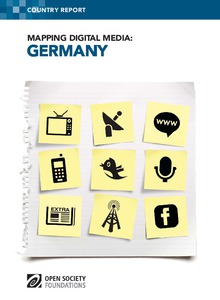Mapping digital media: Germany
"On 25 November 2008, Germany completed the transition from analog to digital terrestrial television transmission. About 90 percent of the population can receive DTT, on the DVB-T standard (Digital Video Broadcasting–Terrestrial). Th e reception of digital satellite television is widespread; in...
| Main Author: | |
|---|---|
| Institution: | ETUI-European Trade Union Institute |
| Format: | TEXT |
| Language: | English |
| Published: |
New York
2011
Open Society Foundations |
| Subjects: | |
| Online Access: | https://www.labourline.org/KENTIKA-19105385124919235679-Mapping-digital-media-Germany.htm |
| Summary: | "On 25 November 2008, Germany completed the transition from analog to digital terrestrial television transmission. About 90 percent of the population can receive DTT, on the DVB-T standard (Digital Video Broadcasting–Terrestrial). Th e reception of digital satellite television is widespread; in 2012, all analog satellite reception will cease. Th e digitization of broadcasting has increased the choice of both public and private television channels. Broadcasters are pushing new channels at niche interests, but the German audience is slow to break with its traditional preferences. (Th e digitization of radio broadcasting has so far attracted negligible consumer interest.) Due to satellite and cable, the media landscape in Germany had a wide choice of television programs even before digitization. (Less than 5 percent of television households have access only to terrestrial television.) Th e most popular TV channels have hardly lost market shares over the last fi ve years, shrugging off the threat from their new digital rivals. Digitization has led to an increasing acceptance of terrestrial transmission overall, which had been declining. In particular, the possibility of mobile use via USB DVB-T sticks seems to make using DVB-T more attractive compared to analog terrestrial signals. ..." |
|---|---|
| Physical Description: | 102 p. Digital |

